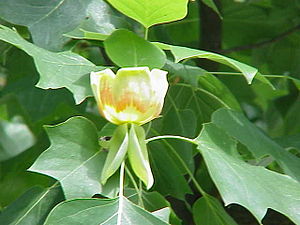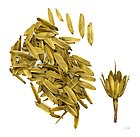Note: This is a project under development. The articles on this wiki are just being initiated and broadly incomplete. You can Help creating new pages.
Difference between revisions of "Liriodendron tulipifera"
(→Photo Gallery) |
|||
| Line 58: | Line 58: | ||
==Photo Gallery== | ==Photo Gallery== | ||
<gallery class="left" caption="" widths="140px" heights="140px"> | <gallery class="left" caption="" widths="140px" heights="140px"> | ||
| − | File:Ham-sur-Heure AR1aJPG.jpg| | + | File:Ham-sur-Heure AR1aJPG.jpg|(Belgium) |
| − | File:Liriodendron tulipifera (arbre) - Laeken.JPG| | + | File:Liriodendron tulipifera (arbre) - Laeken.JPG|Belgium) |
File:Tulpenbaumblatt_unterseite.jpg | File:Tulpenbaumblatt_unterseite.jpg | ||
File:Tulipier de Virginie (11).JPG|Leaves on the tree | File:Tulipier de Virginie (11).JPG|Leaves on the tree | ||
Latest revision as of 11:53, 25 November 2020
Liriodendron tulipifera is a deciduous tree that can grow up to 30.00 metres tall. It is harvested from the wild for local use as a food, medicine and source of materials.
Contents
- 1 Uses
- 2 Parts Used
- 3 Chemical Composition
- 4 Common names
- 5 Properties
- 6 Habit
- 7 Identification
- 8 List of Ayurvedic medicine in which the herb is used
- 9 Where to get the saplings
- 10 Mode of Propagation
- 11 How to plant/cultivate
- 12 Commonly seen growing in areas
- 13 Photo Gallery
- 14 References
- 15 External Links
Uses
Indigestion, Dysentery, Rheumatism, Coughs, Fevers, Wounds, Boils.[1]
Parts Used
Chemical Composition
Earlier investigations on the chemical constituents of L. tulipifera dealt with several alkaloids andsesquiterpenes [3–11]. These studies have shown the isolated products from the stems of L. tulipifera. L. tulipifera was chosenfor further phytochemical investigation.[2]
Common names
| Language | Common name |
|---|---|
| Kannada | |
| Hindi | |
| Malayalam | |
| Tamil | |
| Telugu | |
| Marathi | |
| Gujarathi | |
| Punjabi | |
| Kashmiri | |
| Sanskrit | |
| English | Tulip Tree, American tulip tree |
Properties
Reference: Dravya - Substance, Rasa - Taste, Guna - Qualities, Veerya - Potency, Vipaka - Post-digesion effect, Karma - Pharmacological activity, Prabhava - Therepeutics.
Dravya
Rasa
Guna
Veerya
Vipaka
Karma
Prabhava
Habit
Identification
Leaf
| Kind | Shape | Feature |
|---|---|---|
Flower
| Type | Size | Color and composition | Stamen | More information |
|---|---|---|---|---|
| {{{5}}} |
Fruit
| Type | Size | Mass | Appearance | Seeds | More information |
|---|---|---|---|---|---|
Other features
List of Ayurvedic medicine in which the herb is used
Where to get the saplings
Mode of Propagation
How to plant/cultivate
Requires a deep rich soil and a sheltered but not overshadowed position. Prefers a slightly acid soil. Succeeds in sun or semi-shade.[4]
Commonly seen growing in areas
Deep rich rather moist soils, Mountain slopes, Rich woodlands, Low mountains, Bluffs.
Photo Gallery
References
External Links
- Ayurvedic Herbs known to be helpful to treat Indigestion
- Ayurvedic Herbs known to be helpful to treat Dysentery
- Ayurvedic Herbs known to be helpful to treat Rheumatism
- Ayurvedic Herbs known to be helpful to treat Coughs
- Ayurvedic Herbs known to be helpful to treat Fevers
- Ayurvedic Herbs known to be helpful to treat Wounds
- Ayurvedic Herbs known to be helpful to treat Boils
- Herbs with Bark used in medicine
- Herbs with Roots used in medicine
- Herbs with common name in English
- Habit - Deciduous tree
- Index of Plants which can be propagated by Seeds
- Index of Plants which can be propagated by Layering in spring
- Herbs that are commonly seen in the region of Deep rich rather moist soils
- Herbs that are commonly seen in the region of Mountain slopes
- Herbs that are commonly seen in the region of Rich woodlands
- Herbs that are commonly seen in the region of Low mountains
- Herbs that are commonly seen in the region of Bluffs
- Herbs
- Pages without herbs images







